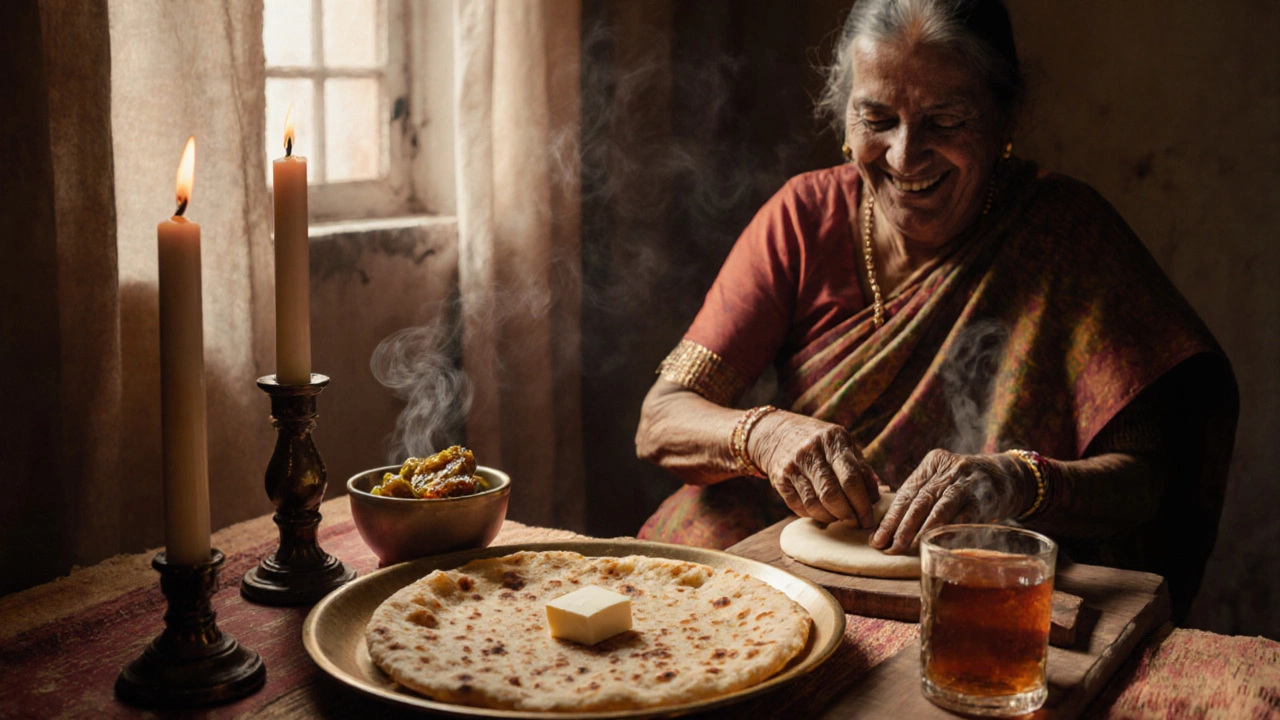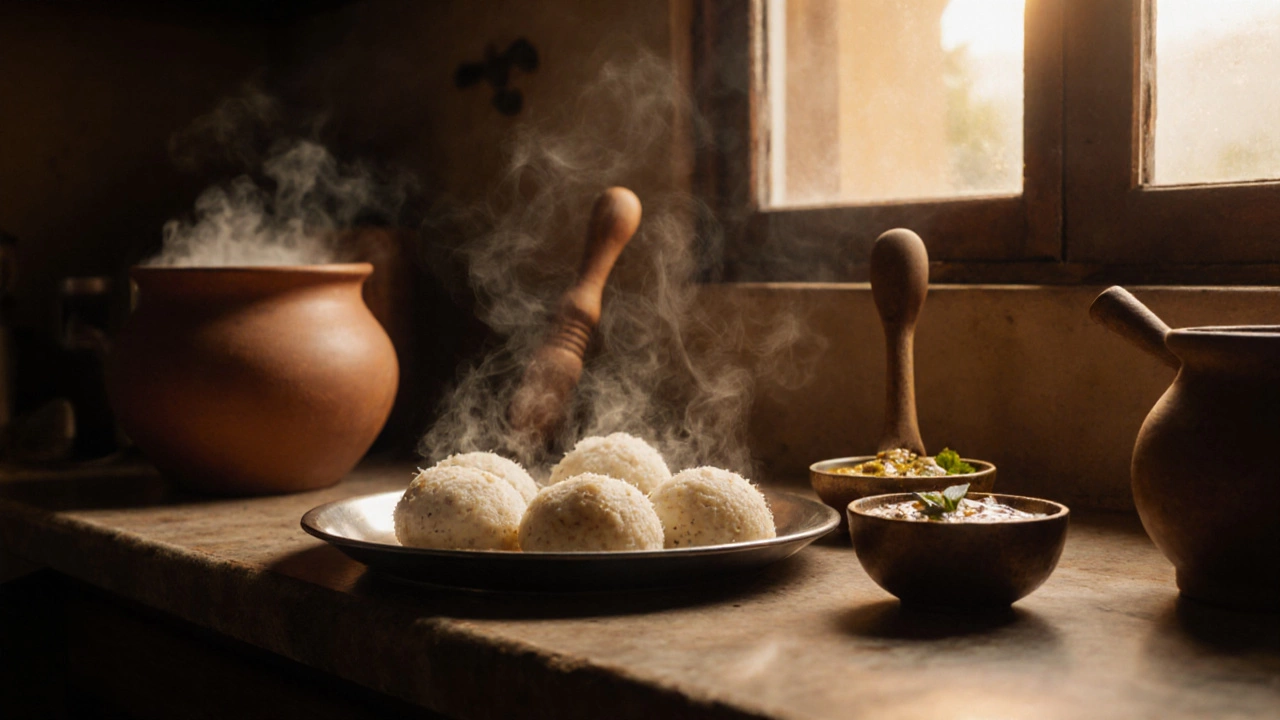Ever wonder what Indians actually eat for breakfast? It’s not just idli and dosa - though those are big. India’s breakfasts change completely depending on where you are, what season it is, and even what time the sun comes up. In the north, people eat hot parathas stuffed with potatoes or paneer. In the south, it’s steamed rice cakes with coconut chutney. In the east, it’s sweet rice pancakes. And in the west, it’s savory poha with peanuts and curry leaves. There’s no single Indian breakfast. There are dozens.
South India: Rice, Fermentation, and Coconut
In Tamil Nadu, Kerala, Karnataka, and Andhra Pradesh, breakfast is built on rice. The most common is idli - soft, steamed rice and lentil cakes. They’re light, easy to digest, and often served with sambar (a lentil-based vegetable stew) and coconut chutney. Most households make idli batter the night before, letting it ferment naturally. No yeast. No machines. Just time and warmth.
Dosa is the crispy cousin of idli. Made from the same fermented batter, it’s spread thin on a hot griddle until golden and crisp. People eat it plain with chutney, or stuff it with spiced potatoes to make masala dosa. You’ll find street vendors flipping dosas at 6 a.m. in Chennai, and families eating them at home in Mysore. It’s not fancy. It’s functional. It keeps you full until lunch.
Then there’s pongal - a savory rice and lentil porridge cooked with black pepper, cumin, and cashews. It’s often eaten during festivals, but in many homes, it’s a weekend breakfast staple. In coastal areas, you’ll see upma too - semolina cooked with onions, peas, and mustard seeds. It’s quick, filling, and works with whatever’s in the pantry.
North India: Bread, Butter, and Spices
Up north, wheat rules. Breakfast isn’t about rice. It’s about bread. The most popular is paratha - a flaky, layered flatbread fried in ghee or oil. You’ll find them stuffed with potatoes (aloo paratha), cauliflower (gobi paratha), or paneer (paneer paratha). People eat them with yogurt, pickle, or a side of butter and jam.
Another favorite is chana masala with bhatura. Bhatura is a deep-fried, puffy bread made from fermented flour. It’s heavy, rich, and often paired with spiced chickpeas. This combo is common in Punjab and Delhi, especially on weekends. It’s not a daily breakfast for most - it’s a treat.
Then there’s poori - small, deep-fried breads that puff up like balloons. Served with potato curry or lentils, they’re a favorite during holidays. In rural areas, people still make them by hand, rolling dough on a wooden board and frying it in cast iron.
Don’t forget halwa paratha. It sounds odd - sweet semolina halwa tucked inside a paratha - but it’s a breakfast staple in parts of Uttar Pradesh and Bihar. It’s sweet, sticky, and deeply satisfying. You eat it with a glass of salty milk tea.
East India: Sweet, Simple, and Slightly Sticky
In West Bengal and Odisha, breakfast leans sweet. The classic is cholar tel - roasted chana (chickpeas) tossed in mustard oil and spices, served with rice cakes called pitha. But the most iconic is rasgulla - soft cheese balls soaked in sugar syrup. Yes, you read that right. People eat dessert for breakfast.
More common is chira - flattened rice soaked in water, mixed with jaggery, banana, and nuts. It’s eaten cold, even in winter. In Assam, they make pitika - mashed potatoes or eggplant mixed with mustard oil and green chilies. It’s served with steamed rice.
Tea is everywhere. Not just any tea - masala chai. Boiled with milk, ginger, cardamom, and sugar. It’s not a side. It’s the anchor. You don’t eat breakfast without it.

West India: Quick, Light, and Flavorful
In Maharashtra and Gujarat, breakfast is about speed and flavor. The star is poha - flattened rice cooked with turmeric, mustard seeds, curry leaves, peanuts, and sometimes potatoes. It takes 10 minutes. It’s healthy. It’s cheap. And every home has their own version.
In Mumbai, you’ll find vada pav at dawn - a fried potato fritter in a bread bun, covered in chutney. It’s street food, but it’s also breakfast. People eat it on the way to work, standing at a stall with a cup of chai.
Then there’s thepla - spiced flatbreads made with fenugreek leaves, whole wheat, and yogurt. They’re made ahead and eaten cold. Perfect for busy mornings. In Gujarat, you’ll also see dhokla - steamed fermented chickpea cakes. Light, tangy, and packed with protein. It’s not just a snack. It’s a meal.
What’s Common Across India?
Despite all the regional differences, a few things stay the same. Tea is non-negotiable. Every breakfast includes it. Not just as a drink - it’s part of the ritual. Boiling milk, crushing ginger, letting it simmer. That’s the sound of an Indian morning.
Spices are used lightly in the morning. Not like dinner. No heavy garam masala. Just mustard seeds, cumin, curry leaves, turmeric, and green chilies. The goal isn’t to overwhelm. It’s to wake you up.
Leftovers get eaten. If you made dal or rice the night before, it becomes breakfast. No waste. No fuss. Just food.
And the timing? Breakfast isn’t a fixed hour. In villages, people eat when they wake up - sometimes at 5 a.m. In cities, it’s 8 or 9. But it’s always before the day gets too hot.

Why These Meals Work
Indian breakfasts aren’t random. They’re smart. Fermented foods like idli and dosa are easy on the stomach. Rice and lentils give you slow-release energy. Spices like turmeric and ginger help digestion. Tea warms you up without being too heavy.
They’re also cheap. A bowl of poha costs less than 20 rupees. A plate of idli and sambar? Under 50 rupees. That’s why they’ve lasted for generations. You don’t need fancy ingredients. Just rice, lentils, spices, and time.
And they’re balanced. Carbs, protein, fat, fiber - all in one plate. No need for cereal or toast. India figured this out centuries ago.
Can You Make Indian Breakfast at Home?
Yes. And you don’t need a special kitchen. Start with poha. It’s the easiest. Rinse flattened rice, sauté mustard seeds and curry leaves in oil, add onions and turmeric, toss in the rice, steam it for 5 minutes, and finish with peanuts and lime. Done.
If you want to try something bigger, make idli batter. Soak rice and urad dal overnight, blend them, let it sit for 8 hours, steam in a mold. It’s not hard. It just takes patience.
Most Indian breakfasts are forgiving. If you forget the peanuts? Fine. Skip the potatoes? Still good. There’s no single right way. That’s the beauty of it.
What About Health?
Some worry about oil and carbs. But traditional Indian breakfasts aren’t the problem. It’s the modern twists - fried dosas drowned in oil, sugary tea with cream, store-bought parathas with hydrogenated fat. Those are new.
Traditional versions are actually quite healthy. Fermented foods improve gut health. Rice and lentils are high in fiber. Turmeric has anti-inflammatory properties. Chai with ginger helps with circulation.
Most Indians don’t eat breakfast out every day. They cook at home. That’s the key. Homemade means control. Control over oil, salt, sugar. And that’s what makes it sustainable.
So if you’re looking for a healthy, flavorful, and filling breakfast - look to India. It’s not about trends. It’s about tradition that works.
